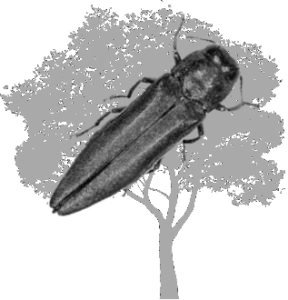By JANE MCCLURE
The battle with emerald ash borer continues in 2019 in St. Paul and around the region. The city’s structured removal program starts this month, with a map and schedules to be released soon. But the pesky insects are moving through St. Paul neighborhoods faster than city forestry crews and dollars can keep up. The goal of the Department of Parks and Recreation is to eradicate the pests by 2024. But that will mean more city and outside funding is needed.
 Removal of trees is to get underway this month, in the neighborhoods north and east of Lake Como. Dozens of trees are affected in an area roughly bounded by Milton St., California Ave., Dale St. and Ivy Ave.
Removal of trees is to get underway this month, in the neighborhoods north and east of Lake Como. Dozens of trees are affected in an area roughly bounded by Milton St., California Ave., Dale St. and Ivy Ave.
Cottage Ave. and Avon and Alameda streets will be among those hard-hit by tree removal.
Several East Side neighborhoods and parts of Highland, Frogtown, and Summit-University will also lose trees. Property owners should have received postcards by now.
Not only is emerald ash borer a focus in the city’s 2019 budget, but it is also called out in the legislative agenda adopted Dec. 19 by the St. Paul City Council. ThaoMee Xiong, intergovernmental relations director for St. Paul, said the city is asking state lawmakers to provide funding to help St. Paul and other cities deal with the pests. That would help cities identify, remove, replace and treat infested trees, through an ongoing grant program with annual funding. A specific dollar amount wasn’t given.
City officials have had mixed success in obtaining state assistance since 2009 when emerald ash borer was found in South St. Anthony Park. That gave St. Paul the dubious distinction of being the first city in Minnesota where the pests were found. Almost the entire city is now directly affected by the insects.
The rising costs of tree removal and replacement are a worry for parks administration and City Council members. But as emerald ash borers spread throughout the state, competition for state grant funding is going to increase. Minneapolis has a special property tax levy for its tree removal and replanting budget.
 With emerald ash borer, the insects’ spread and tree loss accelerate a decade after the first insects are found. St. Paul is hitting the 10-year mark in 2019.
With emerald ash borer, the insects’ spread and tree loss accelerate a decade after the first insects are found. St. Paul is hitting the 10-year mark in 2019.
Department of Parks and Recreation Director Mike Hahm outlined how the pests have bored holes into the city’s budget. The 2018 city budget included more than $1 million in general fund money and $1.5 million in state funding, for a total of $2.593 million to remove and replant trees. The state’s 2017 bonding bill provided the $1.5 million grant to support tree removal and replanting in St. Paul. That grant doesn’t continue into 2019.
The 2019 budget has $1.343 million in ongoing funding, and $1.196 million in one-time funding to continue last year’s level of service into this year. The budget totaled $2.593 million in 2018 and is at $2.539 million in 2019, for a reduction of more than $53,000.
Having more resources in place will allow the parks forestry staff to address emerald ash borer in a more equitable fashion, rather than simply responding to complaints, said Hahm.
Parks had hoped to remove as many as 5,456 trees in 2019, in its budget proposal to Mayor Melvin Carter. But the approved budget for this year allows for removal of about 2,153 trees.
Trees infested with emerald ash borer die over time and their branches become very brittle and fall. Emerald ash borer larvae kill ash trees by tunneling under tree bark and feeding on the trees’ circulatory systems, which move nutrients up and down the trunks.
According to the Minnesota Department of Agriculture, the insects are now found in 17 Minnesota counties and in 35 states around the country.
Minnesota is highly susceptible to the destruction caused by the pests, according to state officials. That’s because Minnesota has approximately one billion ash trees, the most of any state in the nation.
The spread of emerald ash borer has meant that St. Paul has lost many of its ash trees already. Chemical treatments and even stingless wasps have been tried to at least slow the insects’ spread.
Between 2009 and 2017, city crew removed 9,360 of an estimated 26,540 boulevard ash trees and 1,020 of the roughly 10,000 ash trees in its parks.
The 2019 budget calls for removing 1,565 ash trees from boulevards in 2019 and that same number of trees each year after that through 2024. That would leave more than 6,200 ash trees still standing.
In parks, 588 ash trees are targeted for removal in 2019. Removal that same number of trees each year through 2024 would leave more than 4,000 trees still standing.
But that could take a big bite out of the budget, with estimates for boulevard trees rising from almost $3.8 million in 2020 to almost $7.5 million in 2024. For parks, the estimates rise from $1.8 million in 2020 to $4.3 million in 2024.
Comments
No comments on this item Please log in to comment by clicking here